|
Michelle Smart arrived into Louisiana bayou country in the inky pre-dawn darkness of March 11th. The smell of damp earth
and rich green foliage was all she was aware of until the morning’s light revealed the utter devastation that lay in
Hurricane Katrina’s path.
Katrina. Remember Katrina. How could we forget? We were bombarded with newspaper articles, and television images of a city
in its death throes. As the waters receded so did our national attention. The Washington blame game started. The national
print and television media yawned and went on to other hot print or television images. New Orleans and Katrina drifted into
the ebb of or consciousness. We knew that “somebody was going to make things right” and, that the “federal
government would fix it.”
Michelle Smart is the daughter of Stow’s Town Clerk, Linda Hathaway. She was one of thousands of kids who had made
the decision to “pay it back” by donating blood, sweat and tears to clean up the post-Katrina world of New Orleans.
Michelle is staying at government run Camp Premier in Chalamette, Louisiana where they live in single sex, air conditioned
dormitory style tents that hold sixteen people. They can expect two hot meals a day and a bagged lunch.
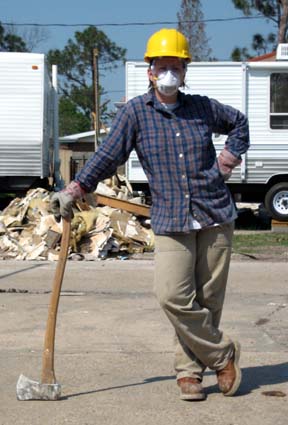
|
| Michelle- Dressed for Work |
These are mostly Michelle’s words written with a hand made heavy through fatigue. They are powerful, emotion laden
and tell a story of loss and renewal—of despair and hope.
Michelle wrote, “The volunteers are from all over America—from all walks of life. She is with Habitat for Humanity
but there are many volunteers from many organizations like AmeriCorps and Samaritan’s Purse. “We are meeting
all kinds of people from all over the country. It is really interesting to strike up a conversation with someone you are
eating next to. There are a lot of schools that have sent their students down on spring break. The camp is full of mostly
college students right now. We are at capacity and it shows. The dinning tent is always filled at dinner times. It is enormous
and has at least 8 rows of tables stretching about 75 yards.”
“The only drawback with having 1300 people in camp is that there are 1300 people fighting over the use of all of the
facilities. I already told you how hard it is to get on the computers. Imagine using the bathroom or the showers. When
we get back from working on the debris removal we aren't allowed to go into our tents until we have showered and washed off
our boots. The lines are enormous. I have been fairly lucky since I am in the first shift. I leave at 7:30 and get back
at 3:30pm.”
Michelle wrote to her Mom on Monday March 13th, “Yesterday was our first day of work. We headed off site at 7:30 a.m.
on buses with our hard hats, goggles, leather gloves and air respirators.”
Respirators are required Michelle explained, “We have to be careful that our air masks are completely sealed around
our face and that they are working well. That is so we don't breathe in any mold spores. Apparently the mold can imbed itself
in your lungs and start to grow there and it is really hard to get rid of.”
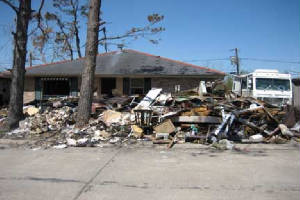
|
| Typical Clean Out |
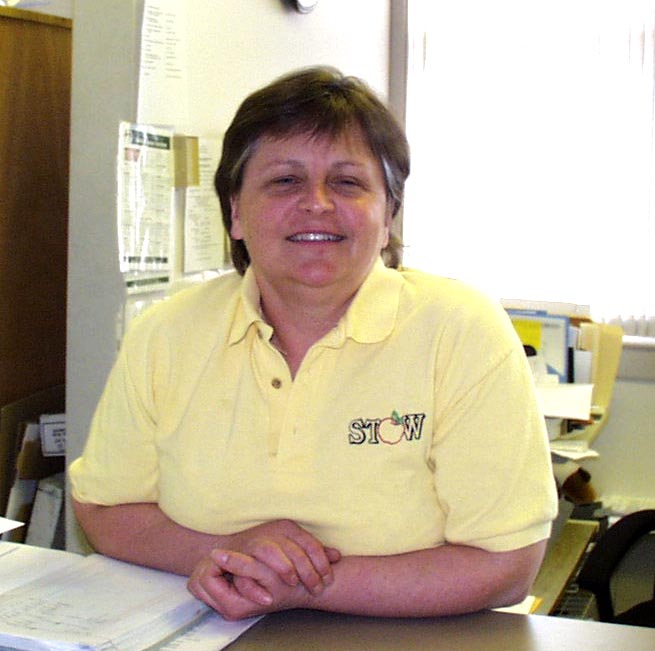
|
| Town Clerk Linda Hathaway |
“I don't think I can really describe the house that we were cleaning out. If you can even imagine all of your belongings
completely ruined, moldy and damp on the floor of your home, an inch of mud on the floor--- on top of everything (with) the
ceiling caving in because it got so wet that it just collapsed from the weight.”
“The smells! I can't even describe the smells. Cups, pots, bowls, washing machines filled with stagnant water. We
tried our hardest not to tip them and spill the water. By far the worst is the fridge which we don't even open. We just
tape it up and hope it doesn't open while we are moving it out. We pile everything up on the curb.”
“We take down the drywall and the insulation all the way down to the studs of the house. When you first walk in you
can't believe that the house can be inhabited again, but by the time you are done you can see some hope. The structure is
usually fairly sound.”
“The pile from our first house we cleaned up was enormous. It was at least 5 feet high and 25 feet long. We take out
everything. We can't save much. All the clothes, furniture, appliances and the like are either growing mold or have rusted
up. I found a 25th anniversary crystal pitcher that was completely intact. But the photo albums are completely gone. You
can't even make out the figures because all of the colors have run together.”
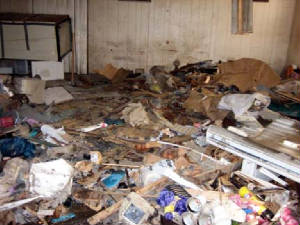
|
| Cleaning Starts Here |
“I found a rolled up American flag in the back of the house and it was in fairly good shape except for a little mud.
I was able to hang it out in front of the house. It was the highlight of the day for me and for many of my teammates, to
be able to walk outside unload a wheelbarrow "full of plaster and insulation and see the flag blowing in the wind. It made
it look like more than a work site, more like a home.”
Moving mountains of debris is tiring, to say the least. “I was exhausted after our first day of work and slept through
my alarm this morning. Today was a little slower as I didn't have as much energy as yesterday. I'm not as sore as I thought
I was going to be. They say you don't really feel it until two days later, so we'll see how tomorrow goes.”
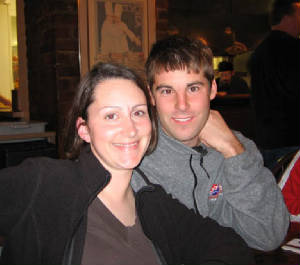
|
| Michelle and Thatcher Woodley |
Given some free time, Thatcher Woodley and Michelle drove into the city. Michelle had never been to New Orleans and she sees
the past, the present and can sense the rebirth of this devastated city.
“The whole drive in was through some of the worst hit towns and cities in Louisiana. From the highway all you could
see was an ocean of blue tarps on everyone's roof. All the restaurants, stores, banks, churches were all closed-- either
boarded up or cleaned out to the studs of the building. I had to get to a post office to mail something. Before I got here
I figured that if I forgot something or needed more shampoo I would just run off the camp and got to the local grocery store.
It didn't even cross my mind that the local grocery store would be 15-20 miles away. Hardly anything is open, except for
a few bars close to camp that are capitalizing on the number of college students at camp this week.”
“We finally got into the city, which I was told wasn't as bad as the residential areas. It was still a ghost town to
me. As we got closer to the French Quarter things started to look more normal but Canal Street which borders the Quarter
is completely wiped out. When I say wiped out I mean all of the shops and stores along the street are boarded up and being
gutted. Huge piles of debris line the sidewalk.”
“We walked through the French Quarter. It seemed to be in fairly good shape. Some stores were closed but most of them
were open. I think the ones that were closed were recovering from some looting. The restaurants that aren't open are recovering
from refrigerators that were not working for weeks. Imagine that mess.”
“I have never been to New Orleans and even with all of the mess you are still able to see a glimmer of what it was and
what it will be in the future. It is unlike any place I have ever been. It definitely has its own vibe. I really want to
get out into some of the jazz and blues joints sometime this weekend. I have already gotten some names of local places to
go.”
Chef/Restaurateur Emeril Lagasse reopened his landmark restaurant on December 5th. Thatcher and Michelle find themselves
rubbing elbows with Emeril.
“Last night a group of us went to Emeril's. It was so much fun. The place was packed! We were wondering if we would
get a chance to see Emeril, but we had heard that he doesn't come down very often. But I was just sitting there and I happened
to glance up and I saw him coming around the corner. No one believed that it was him. They kept saying no it's just someone
who looks similar. But it was definitely him and he went to the table right behind us. I was trying to get my camera and
I accidentally bumped him in the leg. So I touched him! HA HA. Anyway, we weren't able to get a picture so you are just
going to have to take my word for it. The food was great and I left very stuffed, but very happy. It was a lot of fun.
Thatcher and I went with a group of kids from Alaska. They are about our age and just decided to make the trip down. There
were eight of us in total.”

|
| Where Do You Start? |
The weeks pass, Michelle wrote to her Mom, “This has been a very long week. I am exhausted. I have about ten bruises
on my legs alone. But I can feel myself getting stronger.”
Her mother asks her how long Michelle will stay in New Orleans and Michelle replies with a plucky determination, “I
keep saying it will either be when the money runs out in our bank accounts or when we fall over with exhaustion, which ever
comes first.”
It’s a beautiful thing when so many people come together from so many different backgrounds to help the people of New
Orleans recover. “I mentioned it before but the team that I have been working with this week has been amazing. We
are a ragtag group all from different places but we are all hard workers. There is a professor from UNH, a mom from Colorado,
two students from American University, two students from Sienna College, a Canadian, a girl from Phoenix and a student from
Purdue University.”
Life offers us lessons and rewards. Sometimes we look the other way and the lesson or the reward is lost to us—oftentimes
forever. When all you have to give is yourself with no hope of gaining anything other than a scrapbook full of memories,
well, that defines the concept of selflessness—altruism. The rewards are few but when they come, they are usually simple
acts of kindness. Michelle and Thatcher found such a reward in a woman named Elaine.
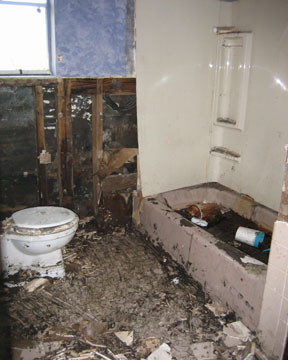
|
| Rub-a-dub Tub |
“We completely finished two houses and helped one woman with her backyard and her bathroom. The last house we worked
on was for this 70 year old woman named Elaine. She was so sweet and so thankful that we were able to help her out. She
was so disappointed that her trailer out in front of her house didn't have electricity because she wanted to make us a hot
lunch.
“Instead she went and got us ice cream which on a hot day was just as good. She was walking around in her white rubber
boots. She said that you can always tell if someone is a true St. Bernardian (Editor’s Note: A St. Bernardian is a
resident of St. Bernard’s Parish—a section of New Orleans which remains one the one of the hardest hit communities.)
if they are wearing white boots. She watched over us and gave a few of us a massage when we took a water break. She told
us stories about her family and the trips she has made. It was hard to get back to work because she was telling us so many
stories.”
“I wanted to badly to listen to her adventures of when she lived in Panama, but I also wanted to make sure I was working
hard to clean out her house. She gave me her phone number and asked that I call her so that she can take us around to show
us New Orleans. She made us promise that we would come back and see the city when it had been fixed up so we could really
experience New Orleans. I wanted so badly to finish cleaning out her home. We just didn't have enough time. Next week she'll
get a new crew of workers whom I'm sure she will be just as kind to.”
Michelle concludes by wishing everyone well. “I hope everyone is doing well. Thank you again for being interested
in my adventures. I also want to encourage anyone who has the time to come down and work. It is a very rewarding experience
and something you will never forget.”
Email Michelle! She loves hearing from the folks back home. Michelle’s email address is smartay16@yahoo.com.
Interesting links about the clean-up project.
http://www.habitat-nola.org/projects/st_bernard.php
Link to frequently asked questions.
http://www.habitat-nola.org/projects/st_bernard_faq.php#num0
For a couple more pictures, look at this link. The pictures are on the far right.
http://www.habitat-nola.org/projects/st_bernard_signup.php
|

